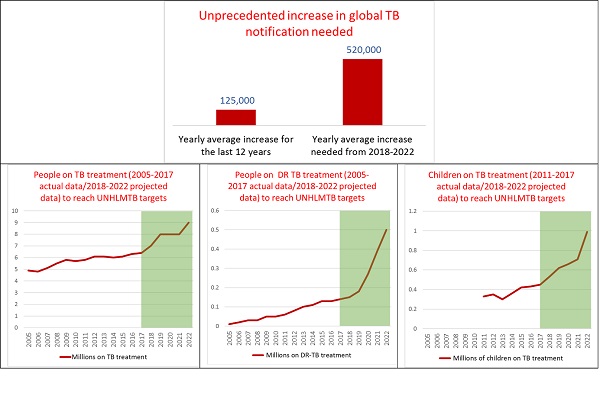Today, the latest Global TB Report was launched by the World Health Organization (WHO), presenting what happened in the TB response in 2017.
And guess what? We are not much different than a year ago.
In fact, we are not that much different than two years ago, or three, or five...
There are still 10 million people who get sick with TB every year. TB remains the most significant single infectious disease killer, causing 1.6 million deaths in 2017. We still miss roughly 4 million people with TB. There are still more than half a million people who got sick with drug-resistant TB. TB incidence continue to decrease at a very slow pace of around 2% a year, woefully insufficient to reach the milestones we have set towards ending TB.
Some may point to the fact that the world notified 100,000 more people with TB than the previous year, and that deaths dropped by more or less the same number. But does it matter if we have 10 million new cases, or 10.2? Does it matter if the numbers are 1.6 million deaths or 1.7? Does it matter that we found and treated 6.3 or 6.4 million people with TB? For all of our collective efforts and new diagnostic tests we used, we were able to put in 2017 only 10,000 more people on treatment for drug-resistant TB, while hundreds of thousands remain suffering. These are people we are failing to help. Our most significant take-home message is that what we did in 2017 and many years before that was not enough and must be changed. We have a timid response and take hesitant actions as we approach obstacles. So, do we have a chance to change this?
This year, in one week, we look towards the most significant, most important meeting in the history of our efforts against TB. We need the UN HLM on TB to be a turning point where the world leaders commit to unprecedented action to End TB.
At the UN HLM the world is committing to scale up diagnosis and treatment of TB and drug-resistant TB at an unprecedented rate as collectively we need to diagnose and treat 40 million people with TB between 2018 and 2022. For example, if in 2017 we diagnosed and treated 6.4 million people with TB that figure needs to be 7 million for 2018! As you can see from the graphs below, the scale-up needs to happen at a pace that we have not yet reached.

However, recent progress in some areas in 2018 gives us hope that it is possible to change.
Last year, the Global Fund to Fight AIDS, Tuberclusosis and Malaria, together with us in the Stop TB Partnership and WHO launched a Strategic Initiative to Reach the People with TB we currently miss. It was a different type of campaign, not the usual slow and gradual approach. It aims to support 13 countries TB programmes to step up efforts and increase the numbers of people detected and treated by 1.5 million in just three years. This kind of ambition was never heard of, and many people thought it was bound to fail. But the Global Fund Secretariat and the country teams, together with partners are taking this seriously and are pushing forward. In India earlier this year, we listened to Indian Prime Minister Narandra Modi speak for 30 minutes about TB and only TB. He outlined a highly ambitious plan to End TB in India by 2025. He has doubled the TB budget, prioritized social and financial support to all people with TB and set bold new targets. India has almost single-handedly driven the increases in case detection we see at a global level, with publicly available notification data that is live. And it is not just India; recent preliminary data in the first half of 2018 show that most of the 13 countries in this initiative have also started to increase case detection after years of stagnation. So, it is possible!
Now, it is too early to say how things will go, but programs like the Global Fund’s Strategic Initiative for TB and the recently launched effort of the same three partners - WHO, Stop TB and Global Fund - "Find.Treat.All" represent, what is needed to catalyze ambition and push scale-up of the TB response.
Next week, the TB community comes together in New York to endorse the commitments to End TB. Every single head of state and government should understand that the Political Declaration is linked to concrete numbers per country of people with TB that must be diagnosed and treated. People we miss. People who suffer. We cannot afford not to do it. So, as difficult as it might sound, we must scale-up and accelerate like never before. We should keep each other accountable for what we deliver and what we don’t, and we should measure our progress with real-time data, to take rapid corrective measures as needed. The world needs to see that our efforts from 2018 and the UN HLM commitments will translate into a change in trajectory and a significant decrease in missed people with TB. The world needs to see that we can defeat TB.
There will be tremendous pressure on all of us and especially on the political leaders that committed to End TB by 2030. We will have to deliver under this pressure, and let's not forget that "...diamonds are made under pressure."
Response of the Stop TB Partnership Secretariat